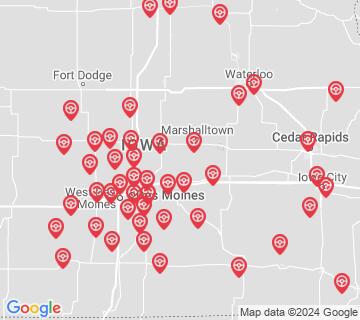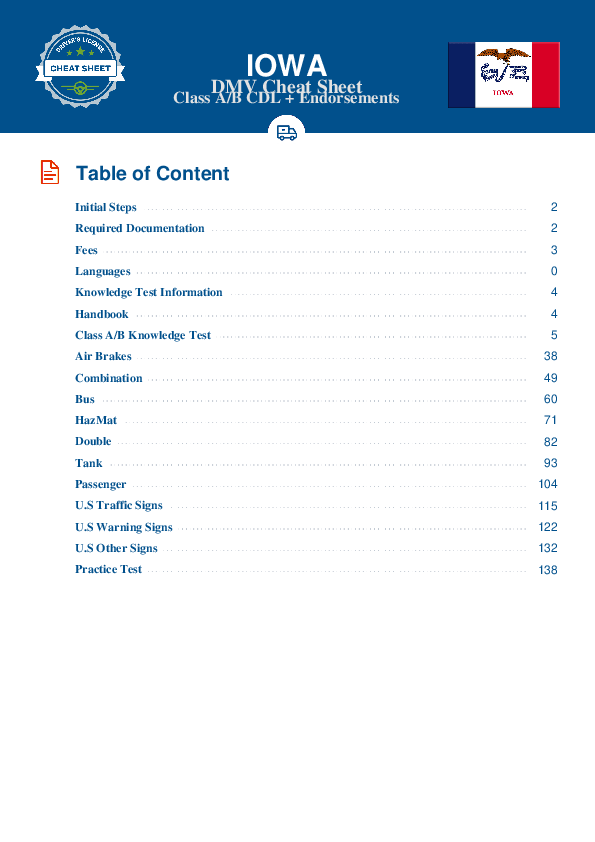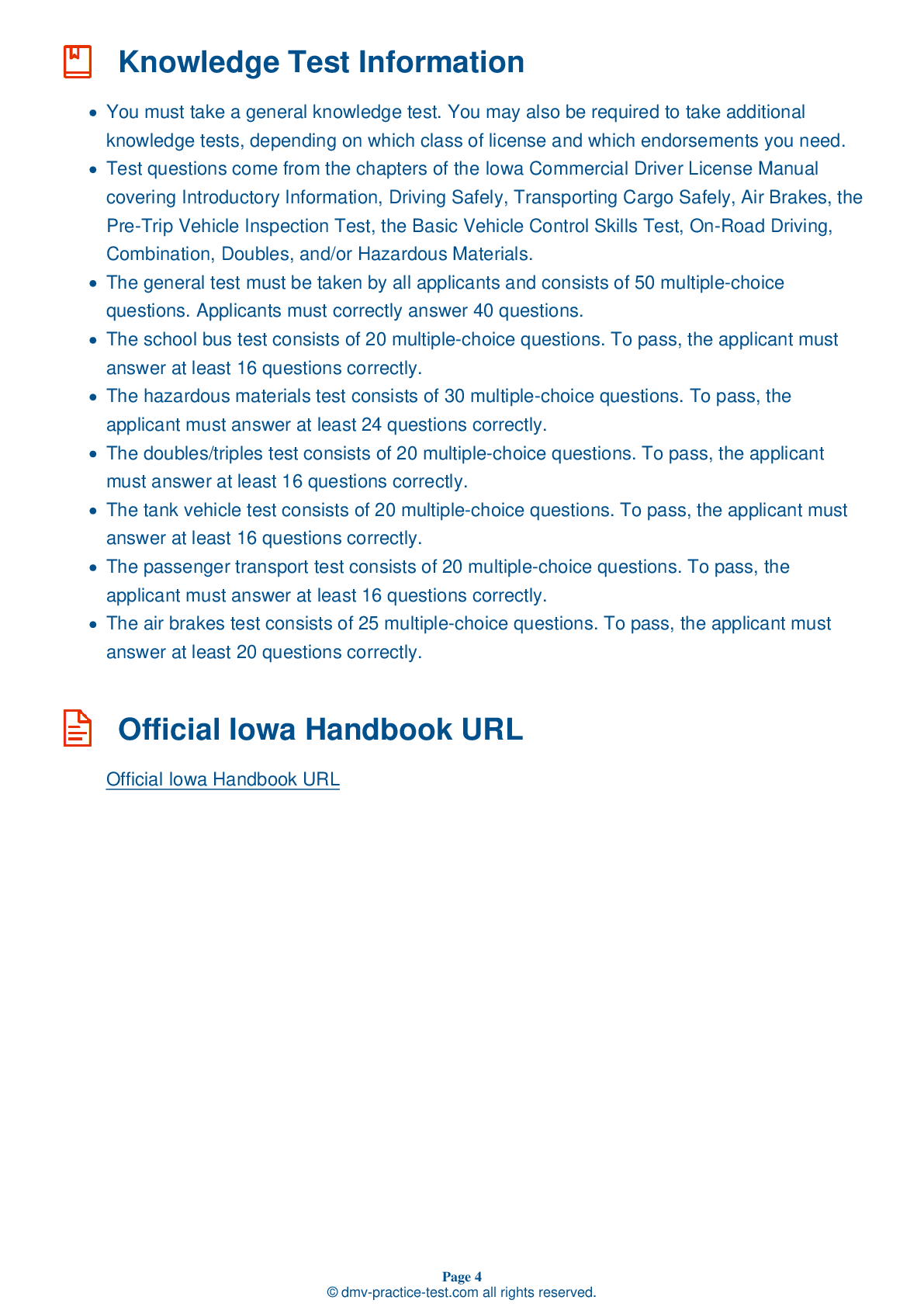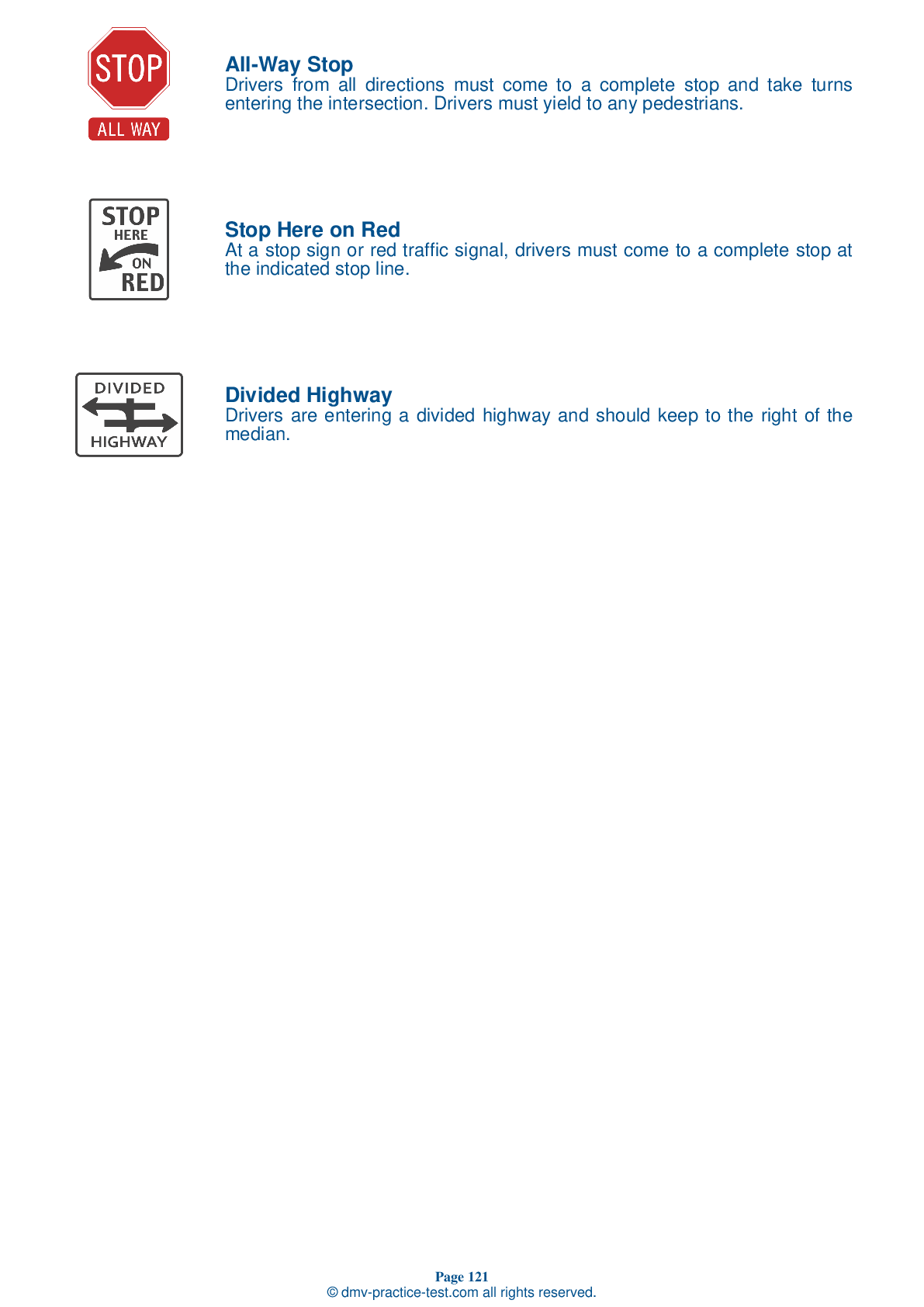Knowledge Test Class A #1
Class A Driving Test | Iowa 2025 #1 Page 3 of 7
Train for FREE online with our Iowa class A license test. The official exam test consists of several obligatory parts, with all of them checking your knowledge of different blocks of road rules. If you need to obtain a IA CDL class A permit in 2025, practice as much as possible. Free sample tests published on our website will help you check and improve your knowledge and boost your grades. Please bear in mind that CDL class A requirements may vary from state to state.
50
40
20
15 . During an applied leakage test, the maximum leakage rate for a triple combination vehicle is ____ in a minute.
It is important to know the maximum air loss rate that is safe for your specific vehicle. A triple combination should have a leakage rate no higher than 6 psi in a minute during an applied leakage test.
16 . When using your turn signal, you should:
Always begin signaling well in advance of a turn. This is the best way to ensure that other drivers do not try to pass you. Without using a turn signal, drivers may assume that you are merely slowing down or stopping when you are planning to turn.
17 . During a pre-trip inspection, belts should be:
Left alone and not inspected.
When inspecting your vehicle, you should check all belts for tightness and excessive wear. You should learn how much "give" is appropriate for each belt.
18 . When approaching a vehicle for a pre-trip inspection, a driver should look under the vehicle:
When approaching your vehicle before an inspection, make note of its general condition and ensure that it is not damaged or leaning. Look under the vehicle for fresh leaks of oil, grease, or fuel. Check around the vehicle for hazards to movement, such as people, other vehicles, or low-hanging wires or tree limbs.
19 . A first felony conviction involving the use of a CMV will result in loss of license for:
Life.
A first conviction of using a CMV in the commission of a felony will result in the loss of your CDL for at least one year. A second conviction will result in loss of license for life.
20 . Having ABS on only one axle:
If you have an Anti-Lock Braking System (ABS) equipped on only the tractor, only the trailer, or only one axle, you will still have more control over the vehicle when braking than you would without ABS. You should brake normally.
21 . If a vehicle is carrying hazardous cargo, placards must be placed:
Placards must be placed on the front, the rear, and both sides of a vehicle carrying hazardous cargo. They must be readable from any direction.
Search the best driving school in your neighbourhood
2025 Iowa | Frequently Asked Questions
To acquire a CDL Hazmat endorsement in Iowa, you need to pass the Hazardous Materials Endorsement Knowledge Test. Additionally, you must undergo a federal background check and fingerprinting. The TSA will assess your application and once approved, the Iowa Department of Transportation will add the endorsement to your CDL.
To obtain a CDL Hazmat license, you must first possess a valid Commercial Driver's License (CDL). You also need to be at least 21 years old, a U.S. citizen or have legal status, and be able to read and speak English. Additionally, you must pass the Hazardous Materials Endorsement Knowledge Test and undergo a federal background check and fingerprinting.
When applying for a CDL Hazmat endorsement in Iowa, you'll need to provide proof of U.S. citizenship or permanent residency, proof of identity, and proof of Iowa residency. Additionally, you'll need to bring your current CDL. A TSA background check and fingerprinting are also required, for which separate documentation may be needed.
Yes, there is a dedicated written test for the CDL Hazmat endorsement. This test is called the Hazardous Materials Endorsement Knowledge Test. It covers topics such as loading and unloading hazardous materials, bulk packaging marking, driving and parking rules, and emergency response procedures.
The written test for the CDL Hazmat endorsement in Iowa covers a wide range of subjects. These include understanding hazardous materials regulations, safety procedures, proper use of shipping papers, placarding, loading/unloading, bulk packaging marking, compatibility and segregation of cargo, and emergency response procedures.
Yes, there are additional fees associated with obtaining a CDL Hazmat endorsement in Iowa. These include a fee for the knowledge test, a fee for fingerprinting, and a fee for the TSA background check. The specific amounts can vary, so it's best to check with the Iowa Department of Transportation for the most current costs.
Yes, obtaining a CDL Hazmat endorsement in Iowa requires a background check. The Transportation Security Administration (TSA) conducts this check, which includes a review of your criminal, immigration, and FBI records. This ensures that you do not pose a security threat while transporting hazardous materials.
Yes, specialized training is required for the CDL Hazmat endorsement in Iowa. This involves understanding hazardous materials regulations, emergency response procedures, and safety protocols. After training, you must pass a written test to get certified. This ensures that drivers are equipped with necessary knowledge to handle hazardous materials safely.
No, you cannot legally transport hazardous materials in Iowa without a valid CDL Hazmat endorsement. This endorsement is required by federal law and ensures that drivers have the necessary knowledge and skills to safely transport hazardous materials. Violating this requirement can result in severe penalties, including fines and suspension of your CDL.
You can add a Hazmat endorsement to your current CDL in Iowa. You don't need to apply for a new CDL. However, you must pass a written test on hazardous materials and complete a TSA security threat assessment, which includes fingerprinting and a background check, to obtain the endorsement.




